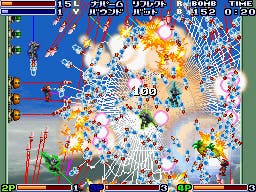Bangai-O Spirits
Buy. Play. Treasure.
So, Bangai-O Spirits. I think it's amazing. I sort of suspect that if you didn't play or love the first one, it'll probably leave you baffled for a long time. And then suddenly you'll have an epiphany, in which you utterly understand it and what it's trying to do.
Some of the time it's like WarioWare; some of the time it's like Gradius; some of the time it's like Brain Training. But you never know what to expect. You never know if a map is going to be over in two seconds, or if you'll be dodging bullets for five minutes. And there are so many nuances, like the counterintuitive process of putting yourself directly in the path of danger because your bombs increase their power in proportion to the number of incoming projectiles, or grasping the need to switch bullets to solve particular puzzles.
It's glorious; eclectic, furiously inventive, dizzying, baffling, confusing, witty, clever and beautiful. There are mazes, there are races, there are block puzzles, there are platform games, there are sports games, there are playful tributes to videogame classics from Pac-Man to Mr. Driller, there's pachinko, there are giant robots, there are giant giant robots, there are Lilliputian giant robots, and there are screens and screens of bullets.
There is perfection, there are flaws, there are moments that test your patience, there are moments that test your endurance, there are moments that test your timing, there are moments that test your intelligence. But, above all, there are moments that send you soaring skywards.

In essence, it is simply a 2D side-scrolling shoot-'em-up. The original Bangai-O (or Bakuretsu Muteki Bangaioh to give it its full name) appeared on the N64, and, in slightly modified format (and as Bangai-O), on the Dreamcast. It featured a brilliantly incomprehensible storyline in which you piloted a big robot (that was tiny on-screen) across 44 levels. It did three important things. The first was that you could choose from either bouncing bullets or homing missiles. The second was that you had bombs, and they increased in power in proportion to the number of enemy bullets that were about to hit you. And the third was that each of those 44 levels was essentially some sort of a puzzle that you had to solve using the first two things.
One map might be balls-out bullet hell to test your reflexes; the next might be an elaborate maze. One level might see you bouncing bullets round corners; the next might see you unleashing waves of homing missiles in large, open spaces. Several missions saw you racing against a fuse; others saw you taking on bosses who didn't actually fight back. Although it was cruelly overlooked by the majority of gamers and critics, it was a game that was brimming with wit and invention - not to mention screens full of explosions and, rather curiously, fruit that recharged your bombs. It was so brilliant, in fact, that it was even elected one of the top 50 games of all time in Hodder Headline's Game On!: From Pong to Oblivion - The Greatest Video Games of All Time. Widely recognised, at least by the authors, as the definitive selection of best ever games ever. [I suppose we did let Ellie get away with the Guinness stuff. Pass. - Ed]







